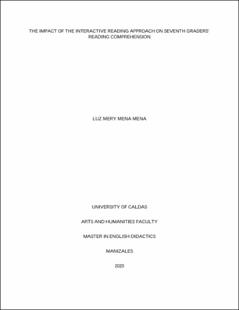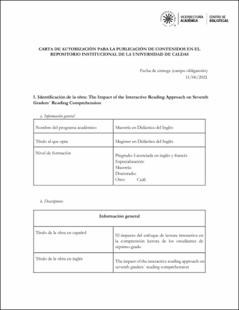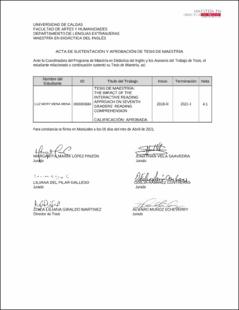Mostrar el registro sencillo del ítem
The impact of the interactive reading approach on seventh graders´ reading comprehension
| dc.contributor | Giraldo Martínez Zoila | |
| dc.contributor.advisor | Giraldo Martinez, Zoila Liliana | |
| dc.contributor.author | Mena Mena, Luz Mery | |
| dc.date.accessioned | 2021-07-09T13:17:26Z | |
| dc.date.available | 2021-06-21 | |
| dc.date.available | 2021-07-09T13:17:26Z | |
| dc.date.issued | 2021-04-05 | |
| dc.identifier.uri | https://repositorio.ucaldas.edu.co/handle/ucaldas/16864 | |
| dc.description | Ilustraciones | spa |
| dc.description.abstract | spa: Esta tesis presenta una investigación de acción con el propósito de analizar el impacto del enfoque de lectura interactivo sobre la comprensión de lectura del alumno en un entorno de EFL. Este estudio se llevó a cabo con el séptimo grado de una escuela pública, ubicada en Manizales-Caldas que, según la etapa de diagnóstico, no pudieron leer en inglés de manera comprensible en el aula. Dentro de una metodología de investigación de acción, reuní los datos con tres técnicas de recolección de datos que se aplicaron en este estudio, incluidas las pruebas de lectura, las observaciones en el aula y una encuesta. Primero, los hallazgos sugirieron que la provisión de instrucciones claras y la inclusión de las actividades centradas en el enfoque de lectura interactiva, ayudaron a los estudiantes a identificar los detalles y las ideas principales, la intencionalidad del autor y la predicción del significado. En segundo lugar, la aplicación de estrategias de comprensión de lectura a los pasajes referidos a las experiencias de la vida real, las palabras, las imágenes, el significado constituyeron una fuente para el compromiso de los estudiantes en el aprendizaje, debido a los materiales innovadores e ilustrativos apropiados que capturaron su atención y se fomentaron la realización de actividades de aprendizaje. y el aprendizaje de vocabulario. | spa |
| dc.description.abstract | eng: This thesis presents an action research with the purpose of analyzing the impact of interactive reading approach on learner’s reading comprehension in an EFL setting. This study was carried out with seventh graders from a public school, located in Manizales-Caldas who, according to the diagnostic stage, were not able to read in English in a comprehensible manner in the classroom. Within an action research methodology, I gathered data with three data collection techniques that were applied in this study including reading tests, classroom observations, and a survey. First, the findings suggested that the provision of clear instructions and the inclusion of activities focused on the interactive-reading approach, helped students to identify details and main ideas, intentionality of the author and prediction of meaning. Second, the application of reading comprehension strategies to passages referred to real-life experiences, words, images, meaning constituted a source for students' engagement in learning, due to the appropriate innovative and illustrative materials that captured their attention and fostered accomplishment of learning activities and vocabulary learning. | eng |
| dc.description.tableofcontents | Table 1. Data collection instrument in the diagnostic stage / Abstract / Introduction / 1. Rationale / 2. Context of the Research, Setting, and Statement of the Problem / 2.1 Description of the Context / 2.2 Statement of the Problem / 3. Research Question and Objectives / 3.1 Research Question / 3.2 Research Objectives / 3.2.1 General objectives / 3.2.2 Specific objectives / 4. Literature Review / 4.1 Theoretical Framework / 4.1.1 Interactive Reading approach / 4.1.2 Approaches in Teaching Reading: / 4.1.3 Bottom-Up model / 4.2 Definition of Reading / 4.2.1 Reading as a Process / 4.2.2 Reading in L1 and L2 / 4.2.3 Reading Strategies / 4.3 Reading Comprehension / 4.4 Previous Related Studies / 5. Methodology / 5.1 Type of study / 5.2 Participants / 5.3 Data collection and instruments / 6. Research stages / Phases of the study / 6.1 Diagnostic stage / 6.1.2 Interviews / 6.1.3 Survey / 6.1.4 Pre-test / 6.1.5. Findings during the diagnostic stage / 6.2 Action stage / 6.2.1 Workshops / 6.2.1.1 Workshop N° 1 / Sample of lesson / Workshop N° 1 / 6.2.1.2 Workshop N° 2 / 6.2.1.3 Workshop N° 3 / 6.2.1.4 Workshop N° 4 / 6.2.1.6 Workshop N° 6 / 6.3 Evaluation Stage / 6.3.4 Data triangulation of the six workshops / 7. Findings / 8. Conclusions / References / Appendixes / Appendix 1. Researcher’s Journal format / Appendix 2. External observer’s check list format / Appendix 3. Students’ Pre-test, and Post-test / Appendix 4. Entries / Appendix 5. Research interview / Appendix 6. Survey | eng |
| dc.format.mimetype | application/pdf | spa |
| dc.language.iso | eng | spa |
| dc.language.iso | spa | spa |
| dc.title | The impact of the interactive reading approach on seventh graders´ reading comprehension | eng |
| dc.type | Trabajo de grado - Maestría | spa |
| dc.description.degreelevel | Maestría | spa |
| dc.identifier.instname | Universidad de Caldas | spa |
| dc.identifier.reponame | Repositorio institucional Universidad de Caldas | spa |
| dc.identifier.repourl | https://repositorio.ucaldas.edu.co | spa |
| dc.publisher.faculty | Facultad de Artes y Humanidades | spa |
| dc.publisher.place | Manizales | spa |
| dc.relation.references | Abbott, M. L. (2006). ESL reading strategies: Differences in Arabic and Mandarin speaker test performance. Language Learning, 56(4), 633-670. | spa |
| dc.relation.references | Abraham, P. (2000). Skilled reading: Top-Down, Bottom-Up. Field notes, 10(2), 1& 6-8. | spa |
| dc.relation.references | Alderson, J. (1989). Reading in a foreign language. London: Longman. | spa |
| dc.relation.references | Anderson, N. (2004). Metacognitive Reading Strategy Awareness of ESL and EFL Learners. The CATELSON journal, 16(1), 11- 27. | spa |
| dc.relation.references | Brown, H. D, (2006), Principles of Language Learning and Teaching, New York: Pearson Education, p. 7-8. | spa |
| dc.relation.references | Brown, H. D. 2007. Teaching by Principles. England Cliffs. New Jersey: Prentice Hall. | spa |
| dc.relation.references | Burns, A. (1999). Doing action research in English language teaching: A guide for practitioners. New York: Routledge. | spa |
| dc.relation.references | C. Block and S. Isael, Reading First and Beyond: The Complete Guide for Teachers and Literacy Coaches, Thousand Oaks, CA: Corwin Press, 2005. | spa |
| dc.relation.references | Carrell, P.L. (1998). Readability in ESL. Reading in a Foreign Language, 4, 21-40. | spa |
| dc.relation.references | Clarke, P. J., Truelove, E., Hulme, C., & Snowling, M. J. (2014). Developing reading Comprehension. West Sussex, UK: John Wiley & Sons, Ltd | spa |
| dc.relation.references | Creswell, J (2009). Research design: qualitative, quantitative, and mixed methods approach. Los Angeles: sage | spa |
| dc.relation.references | Cunningham, A. E., & Stanovich, K. E. (1997). Early reading acquisition and its relation to reading experience and ability 10 years later. Developmental Psychology, 33(6). 934-945. doi: 10.1037/0012-1649.33.6.934. | spa |
| dc.relation.references | Echeverri, L.M., McNulty F(2003). Reading strategies to develop higher thinking skills for reading comprehension. PROFILE JOURNAL Vol. 12, No. 1, 2010. ISSN 1657-0790. Bogotá, Colombia. Pages 107-123 | spa |
| dc.relation.references | Eslami-Rasekh, Z., & Valizadeh, K. (2004). Classroom activities viewed from different perspectives: Learners’ voice and teachers’ voice. TESL-EJ, 8(3), 1-13. | spa |
| dc.relation.references | Fletcher-Janzen, E., Reynolds, C. R., & Vannest, K. J. (2013). Reading Comprehension. In Encyclopedia of Special Education: A Reference for the Education of the Handicapped and Other Exceptional Children and Adults. Hoboken, NJ: Wiley | spa |
| dc.relation.references | Freeman, D. (1998). Doing teacher research: from inquiry to understanding. NY: Heinle and Heinle publisher | spa |
| dc.relation.references | Freire, P., & Macedo, D. (2013). Literacy: Reading the word and the world. New York, NY: Routledge. | spa |
| dc.relation.references | Gersten, R., Fuchs, L. S., Williams, J. P., & Baker, S. (2001). Teaching reading comprehension strategies to students with learning disabilities: A review of research. Review of educational research, 71(2), 279-320 | spa |
| dc.relation.references | Grabe, W. (2009). Reading in a second language: Moving from theory to practice. Cambridge, UK: Cambridge University Press | spa |
| dc.relation.references | Gunning, T. (2010). Creating literacy instruction for all students. Boston, MA: Pearson Education, Inc. | spa |
| dc.relation.references | Harmer, J (2010). How to teach English. Pearson Longman | spa |
| dc.relation.references | Hedge, T. (2000). Teaching and learning in the language classroom. Oxford: Oxford University Press. | spa |
| dc.relation.references | Hoeh, E. (2015). Mapping a path to understanding: Supporting the comprehension of narrative text for students with learning disabilities and typically developing peers. (Doctoral Dissertation). Retrieved from http://www.proquest.com | spa |
| dc.relation.references | Irwin and Baker (1989). Understanding and teaching reading. Reading comprehension in teaching English as a foreign language. | spa |
| dc.relation.references | Jansen, H. (2010). The logic of qualitative survey research and its position in the field of social research methods. In Forum Qualitative Sozialforschung/Forum: Qualitative Social Research 11(2) | spa |
| dc.relation.references | Laddo, The Important of Reading. [Online]. Available: http://www.squidoo.com/the -importance-ofreading [13 November 2007]. | spa |
| dc.relation.references | Lankshear, C. & Knobel, M. (2006). A Handbook for teacher Research from design to implementation. New York: Open University Press. | spa |
| dc.relation.references | Lopera, S. (2015). The design process of a reading comprehension manual. Colombian Applied Linguistic Journal, 17(1), 130-141. | spa |
| dc.relation.references | Manzo, A. V. (1990). Content area reading: A heuristic approach. Columbus, OH: Merrill Publishing Company. | spa |
| dc.relation.references | McNamara, D. S. (2007). Reading comprehension strategies: Theories, interventions, and technologies. New York, NY: Lawrence Erlbaum Associates. | spa |
| dc.relation.references | Mikulecky, B. S., & Jeffries, L. (2005). Reading power: Reading for pleasure, comprehension skills, thinking skills, reading faster. White Plains, NY: Longman | spa |
| dc.relation.references | Ministerio de Educación Nacional [MEN]. (1994). Ley General de Educación (Ley 115 del 8 de Febrero de 1994) Retrieved August 30, 2012 from http://www.mineducacion.gov.co/ 1621/articles85906_archivo_pdf.pdf. | spa |
| dc.relation.references | Ministerio de Educación Nacional [MEN]. (2006). Estándares Básicos de Competencias Inglés. Formar en lenguas extranjeras: ¡el reto! Lo que necesitamos saber y saber hacer. Colombia. | spa |
| dc.relation.references | Ministerio de Educación Nacional [MEN]. (2014). Programa Nacional de Inglés Colombia Very Well 2015-2025. Retrieved from: http://www.colombiaaprende.edu.co/html/micrositios/1752/articles343287_recurso_1.pdf | spa |
| dc.relation.references | Morales, K.N.S. 2010. Promoting the Reading Comprehension of Freshmen Engineering Students through an Interactive Approach to Content-Based Materials. Philippines ESL Journal, Vol. 5, July 2010 | spa |
| dc.relation.references | Núñez, A., & Téllez Téllez, M. F. (2009). ELT materials: The key to fostering effective teaching and learning settings. PROFILE: Issues in Teachers Professional Development, 11(2), 171-186. | spa |
| dc.relation.references | Nuñez, A. & Téllez, M. F. (2015). Reflection on teachers’ personal and professional growth Through a Materials Development Seminar. How Journal, 22(2), 54-74. | spa |
| dc.relation.references | Nuttall, C, (1996), Teaching Reading Skills in a Foreign Language. Oxford: Heinmann. p. 118. | spa |
| dc.relation.references | Nuttall, C. (2000). Teaching reading skills in a foreign language. Oxford: Macmillan | spa |
| dc.relation.references | Pardo, L. S. (2004). What every teacher needs to know about comprehension. The reading teacher, 58(3), 272-280. | spa |
| dc.relation.references | Pesa, N., & Somers, S. (2007). Improving reading comprehension through application and transfer of reading strategies (Master's thesis, Saint Xavier University). Retrieved from http://www.eric.ed.gov/ERICDocs/data/ericdocs2sql/ content_storage_01/0000019b/80/28/0c/59.pdf [ Links ] | spa |
| dc.relation.references | Quiroga, C. (2010). Promoting tenth graders' reading comprehension of academic texts in the English class. PROFILE Issues in Teachers' Professional Development, 12(2). 11-32. | spa |
| dc.relation.references | Reutzel, D.R., & Cooter, R. B (2013). Bottom-Up theories of the reading process. | spa |
| dc.relation.references | Richard, J. C. & Schmidt, R, (2002), Longman Dictionary of Language Teaching and Applied Linguistics, England: Pearson Education Limited, p. 99. | spa |
| dc.relation.references | Ríos, S., & Valcárcel, A. (2005). Reading: A meaningful way to promote learning English in high school. PROFILE JOURNAL 6, 2005. Bogotá, Colombia. Pages 59-72. | spa |
| dc.relation.references | Schmitt, N (2000) Vocabulary in Language Teaching. Cambridge: Cambridge University Press | spa |
| dc.relation.references | Smith, F, (2004), Understanding Reading: A Psycholinguistic Analysis of Reading and Learning to Read Sixth Ed, New Jersey: Lawrence Erlbaum Associates, p. 3. | spa |
| dc.relation.references | Snow, C. (2002). Reading for understanding: Toward an R&D program for reading comprehension. Rand Corporation. | spa |
| dc.relation.references | Wallace, C. (2003). rt. New York: Palgrave Macmillan. | spa |
| dc.relation.references | Weaver, C. (2009). Reading Process: Brief edition of reading process and practice. Canada: Heinemann | spa |
| dc.relation.references | Webb, S. (2007). The Effects of Repetition on Vocabulary Knowledge. Applied Linguistics, 28, 46-65. | spa |
| dc.relation.references | Wolley, G. (2008). The assessment of reading comprehension difficulties for reading intervention. Australian Journal of Learning Difficulties, 13(1), 51-62. doi:10.1080/19404150802093729 | spa |
| dc.relation.references | Woolley, G. (2011). Reading Comprehension: Assisting Children with Learning Difficulties, Springer Science+Business Media B.V. | spa |
| dc.rights.accessrights | info:eu-repo/semantics/openAccess | spa |
| dc.subject.proposal | Interactive reading approach | eng |
| dc.subject.proposal | Reading strategies | eng |
| dc.subject.proposal | Reading comprehension | eng |
| dc.subject.unesco | Investigación pedagógica | |
| dc.subject.unesco | Pedagogía | |
| dc.type.coar | http://purl.org/coar/resource_type/c_bdcc | spa |
| dc.type.content | Text | spa |
| dc.type.driver | info:eu-repo/semantics/masterThesis | spa |
| dc.type.version | info:eu-repo/semantics/publishedVersion | spa |
| oaire.version | http://purl.org/coar/version/c_ab4af688f83e57aa | spa |
| oaire.accessrights | http://purl.org/coar/access_right/c_f1cf | spa |
| dc.description.degreename | Magister en Didáctica del Inglés - Manizales | spa |
| dc.publisher.program | Maestría en Didáctica del Inglés - Manizales | spa |







